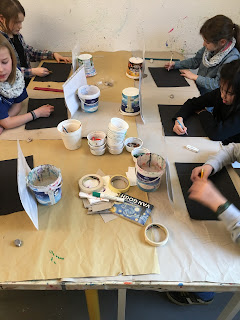 |
| Van Gogh 'Starry Night', 1889 |
Yeah, not something I wanted to try on my kids. So for my 7-13 year old age group I decided to do it with oil pastels on black paper. Wow! What stunning results we got! The colors were creamy, blended, vibrant and textured. The black paper takes it all down a notch and gives it that mysterious quality, while allowing the colors to pop off the dark background. These were super successful! But this is not to say that it was a very difficult and labor intensive project. Our wrists were kinda hurting by the end too, with all the repetitive motion. It took one group two 90-minute classes, the other group took a bit longer. But we came away learning so much about layering, blending oil pastels, creating movement, and using our artist eyes to observe every dash and color detail of Van Gogh's masterpiece with upmost precision. And another great benefit of this project? We used the grid method to draw the landscape. This ensured that all our stars, hills, waves and houses had their precise and rightful place in our composition. Another reason these look SO much like the original!
 |
| Teacher Sample, oil pastel on black paper |
Materials:
Black construction paper
'Starry Night' print-out for each student (in a plastic sleeve, taped to a yogurt jug to stand it up)
Oil pastels: black, white, brown, yellow, orange, dark green, light blue, middle blue, dark blue.
Process:
Students created a grid on their Van Gogh 'Starry Night' print out, and then a grid on their black drawing paper. Using pencil, they then began lightly drawing in the composition grid for grid. For most of my students this was a new concept, but even the youngest students grasped the concept quickly and were well on their way to mapping out their Starry Night with precision.
 |
| Teacher demonstrating step-by-step coloring and blending. |
We used dashes of blue for the hills and overplayed with dashes of white, which resulted in blended tints of blues. We did the same with the green in our hills, adding dashes of white and yellow, resulting in tints of green and yellow-greens. Our houses were done in light blue and overplayed with white. We noted that the houses, tree and hills are all outlined in black. The church with church steeple seems to be the focal point in the lower part of the painting, so we were sure to emphasize this by ensuring it was big and bold enough, and highlighted enough to make it draw the viewer's attention.

We continued like this, closely examining and working out each area at a time, and being mindful of how to achieve the appropriate color, texture and feel of movement through blending, layering, and line work.
Those who wanted/needed to, followed along with me, while the more independent/advanced students colored at their own pace and using their own intuition. After a short time of me demonstrating, nearly all students were working independently. I ceased demonstrating on the my own sample, and offered individual guidance where needed.
 |
| Our set up: 'Starry Night' visual. Close observation. |
We first colored the bottom half our our composition (land, mountains, houses and tree).
In our next class session we addressed the sky in the same meticulous, close observational way. We noticed that the swirls are the focal point in the sky, and were sure to emphasize this element with extra highlights.
 |
| Day 1. Bottom half complete! |
 |
| 8-10 year olds |
 |
| 7-13 year olds |





































